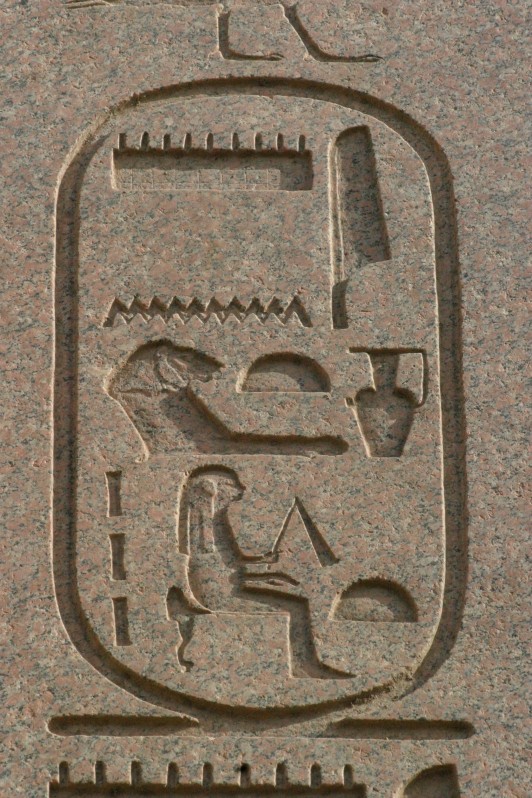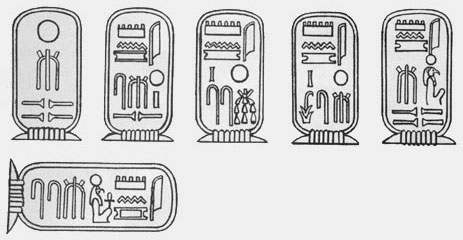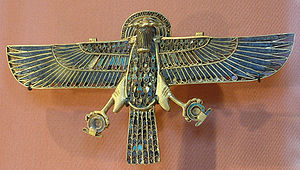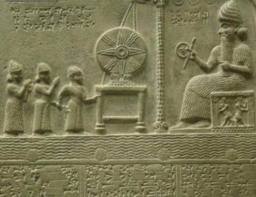Egypt
The Shen throughout the ancient peoples on various religions and ethnic groups all seemed to have a symbol, Shen, Cartouche, or the Omega that represented life.
For further reading;
http://trueancienthistory.blogspot.ca/2013/05/the-peoples-and-languages-shifting.html
- Online: The Organization Of The Pyramid Texts (2 Vol. Set)
Brill Online Author: Harold M. Hays Subjects: Ancient Near East & Egypt Overview Chapters (17) The ancient Egyptian Pyramid Texts form the oldest body of religious texts in the world. This book weds traditional...
- Online: Le Musée Egyptien
DigiZeitschriften Thanks to Chuck Jones and his Ancient World Online blog for this link. Le Musée Egyptien al-Mathaf al-Misrī 1909-1915 Le Musée Egyptien Band 3 1904-1907 Le Musée Egyptien Band 2 ...
- The Ancient Calendar Of The Akkadians Compared To Modern Jewish Calendar
The Akkadian Calendar ...
- Tuesday's Egyptian
...
- The Avenue Of Sphinx's
So here we are presented with the completion of part of the avenue of sphinx's at Luxor. A complicated tale to resurrect an ancient processional way between Karnak temple and Luxor temple. The project may be one of the best examples of...
Egypt
Egyptian Hieroglyphs
Historical Background of Egyptian Hieroglyphs
1) In 1799 a Frenchman, attached to Napoleon’s army found the Rosetta Stone near Alexandria in Egypt.


The Rosetta stone;
2)After the surrender of Egypt to the British forces in 1801, the Rosetta stone, eventually landed in the British Museum.
3)The Rosetta stone, had three identical texts written in three languages. Two of these were in Egyptian, one of these being Hieroglyphs, and the other in Greek.
4) Two men eventually were able to decipher the Egyptian text on the stone by 1822. First Young, an Englishman, was able to decipher the cartouches. These were 7 exact symbols of a Pharaoh's name surrounded by an elliptical circle with a horizontal line at one end, found written on the stone. Later a Frenchman, Champollion, was able to decode the rest of the text, all with the aid of the Greek inscription.
5) An usual aspect of Hieroglyphics is it can be written and read in several directions as in top to bottom or right to left, which is usual.. The key to reading the text really depends on which way the characters are facing. If they face to the right then the text is read from the right.

Hatshepsut Cartouche

Above are examples of Egyptians text representative of the word Ramsses in numerous cartouches..
1) The Circle or the God Ra in the cartouche gives the sound "Rah". Often the circle, representing the sun, will have a dot in the centre.
2) The hanging plant with 3 limbs gives the sound "M" ( from good to eat sound, plant looks very much like the letter "M")
3) The double staffs or sticks, gives the sound "S,S"
4) The hanging plant and the staff together, gives the sound, "MEES"
The proper way to pronounce Ramsses, Is not RAM-first syllable, SES 2nd syllable. There is no RAM syllable in ancient Egyptian. Ra is the Sun God not Ram. The correct syllables and pronunciation is RAH- MSES. Similar to the word David. David is a Hebrew name and is pronounced. DAH-VEED.The English pronunciation is DA-VID, which is incorrect.

5) An usual aspect of Hieroglyphics is it can be written and read in several directions as in top to bottom or right to left, which is usual.. The key to reading the text really depends on which way the characters are facing. If they face to the right then the text is read from the right.

Hatshepsut Cartouche

Above are examples of Egyptians text representative of the word Ramsses in numerous cartouches..
1) The Circle or the God Ra in the cartouche gives the sound "Rah". Often the circle, representing the sun, will have a dot in the centre.
2) The hanging plant with 3 limbs gives the sound "M" ( from good to eat sound, plant looks very much like the letter "M")
3) The double staffs or sticks, gives the sound "S,S"
4) The hanging plant and the staff together, gives the sound, "MEES"
The proper way to pronounce Ramsses, Is not RAM-first syllable, SES 2nd syllable. There is no RAM syllable in ancient Egyptian. Ra is the Sun God not Ram. The correct syllables and pronunciation is RAH- MSES. Similar to the word David. David is a Hebrew name and is pronounced. DAH-VEED.The English pronunciation is DA-VID, which is incorrect.
The Egyptians also had representation of the cartouche that included an Omega like object (symbol) that connects man to the chariots of the Gods. An artistic representation of the chariots of the Gods from the Sumerians, that the Egyptians used is the figure below. Note what is held in it's claws, and it's shape.
In this case of the Egyptians, the object was the Shen, the Symbol that represented eternity, which in the figure above is holding in his claws. The Shen is made up of a rope and staff, that is also depicted in an elongated form, known as a cartouche. In the cartouche, the rope is extended to surround a King's name. Hence Shen can also mean, "to encircle". Both the Omega and the Shen are quite similar in appearance, and had similar meaning to these ancient people.
The ancient people of Israel also had a God that held a shen;
The ancient people of Israel also had a God that held a shen;
Ezekiel in his vision for the rebuilding of the 2nd temple, (Ezekiel 40 2-4); he was approached by YHWH caring a Shen. "In a Godly vision,...approached by a man who had the appearance of bronze and who held in his hand a flaxen string and a measuring rod."
The Sumerians also had a Shen like object, seen in the figure below, which was again represented by a measuring staff and rope. (Compare it to the Egyptian Shen) The Anunnaki figure holding it shows his authority in measuring mans life.

The Shen throughout the ancient peoples on various religions and ethnic groups all seemed to have a symbol, Shen, Cartouche, or the Omega that represented life.
5)With the fall of Egypt's power, Egypt became more isolated. It's religion and it's Hieroglyphic texts became more obscure. There may have been a time when foreign scholars, Roman and Greek, could read Egyptian text, but this is unknown. By the 1st Century A.D., Hieroglyphs certainly was falling into disuse.
For further reading;
http://trueancienthistory.blogspot.ca/2013/05/the-peoples-and-languages-shifting.html
- Online: The Organization Of The Pyramid Texts (2 Vol. Set)
Brill Online Author: Harold M. Hays Subjects: Ancient Near East & Egypt Overview Chapters (17) The ancient Egyptian Pyramid Texts form the oldest body of religious texts in the world. This book weds traditional...
- Online: Le Musée Egyptien
DigiZeitschriften Thanks to Chuck Jones and his Ancient World Online blog for this link. Le Musée Egyptien al-Mathaf al-Misrī 1909-1915 Le Musée Egyptien Band 3 1904-1907 Le Musée Egyptien Band 2 ...
- The Ancient Calendar Of The Akkadians Compared To Modern Jewish Calendar
The Akkadian Calendar ...
- Tuesday's Egyptian
...
- The Avenue Of Sphinx's
So here we are presented with the completion of part of the avenue of sphinx's at Luxor. A complicated tale to resurrect an ancient processional way between Karnak temple and Luxor temple. The project may be one of the best examples of...
